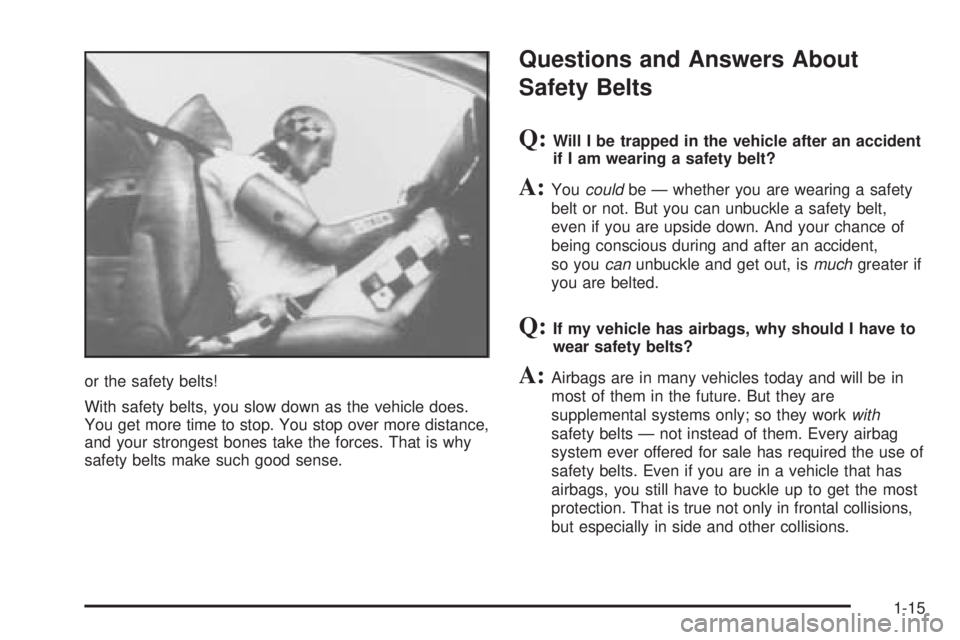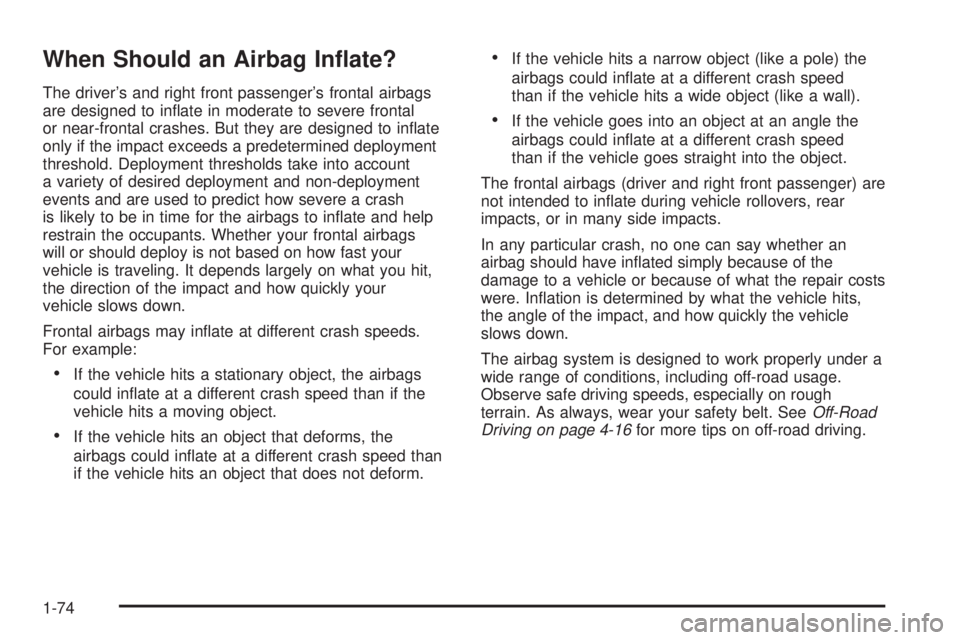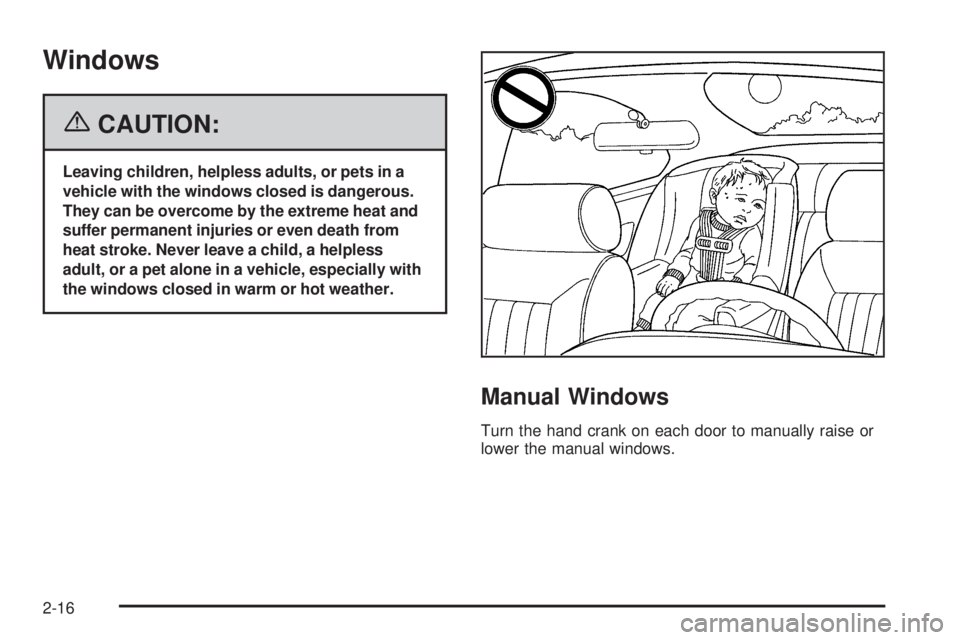2006 GMC SIERRA ESP
[x] Cancel search: ESPPage 21 of 600

or the safety belts!
With safety belts, you slow down as the vehicle does.
You get more time to stop. You stop over more distance,
and your strongest bones take the forces. That is why
safety belts make such good sense.
Questions and Answers About
Safety Belts
Q:Will I be trapped in the vehicle after an accident
if I am wearing a safety belt?
A:Youcouldbe — whether you are wearing a safety
belt or not. But you can unbuckle a safety belt,
even if you are upside down. And your chance of
being conscious during and after an accident,
so youcanunbuckle and get out, ismuchgreater if
you are belted.
Q:If my vehicle has airbags, why should I have to
wear safety belts?
A:Airbags are in many vehicles today and will be in
most of them in the future. But they are
supplemental systems only; so they workwith
safety belts — not instead of them. Every airbag
system ever offered for sale has required the use of
safety belts. Even if you are in a vehicle that has
airbags, you still have to buckle up to get the most
protection. That is true not only in frontal collisions,
but especially in side and other collisions.
1-15
Page 48 of 600

There is limited space in the rear seating area of an
extended cab model. If you want to secure a child
restraint in a rear seating position of an extended cab
model, especially in the rear center position, be
sure to study the instructions that came with your child
restraint to see if there is enough room to secure
your seat properly.
If your vehicle has the passenger sensing system or the
airbag off switch and you need to secure a rear-facing
child restraint in the right front passenger’s seat,
the passenger’s frontal airbag must be off. See
Passenger Sensing System on page 1-81,Airbag Off
Switch on page 1-78,Securing a Child Restraint in
the Right Front Seat Position (Regular and Extended
Cab) (With Airbag Off Switch) on page 1-59orSecuring
a Child Restraint in the Right Front Seat Position
(Regular and Extended Cab) (With Passenger Sensing
System) on page 1-65for more on this including
important safety information.
Wherever you install a child restraint, be sure to secure
the child restraint properly.
Keep in mind that an unsecured child restraint can
move around in a collision or sudden stop and injure
people in the vehicle. Be sure to properly secure
any child restraint in your vehicle — even when no child
is in it.Lower Anchors and Tethers for
Children (LATCH)
Your vehicle has the LATCH system. The LATCH
system holds a child restraint during driving or in a
crash. This system is designed to make installation of a
child restraint easier. The LATCH system uses
anchors in the vehicle and attachments on the child
restraint that are made for use with the LATCH system
Make sure that a LATCH-compatible child restraint is
properly installed using the anchors, or use the vehicle’s
safety belts to secure the restraint, following the
instructions that came with that restraint, and also the
instructions in this manual. When installing a child
restraint with a top tether, you must also use either the
lower anchors or the safety belts to properly secure the
child restraint. A child restraint must never be installed
using only the top tether and anchor.
In order to use the LATCH system in your vehicle, you
need a child restraint equipped with LATCH attachments.
The child restraint manufacturer will provide you with
instructions on how to use the child restraint and its
attachments. The following explains how to attach a child
restraint with these attachments in your vehicle.
1-42
Page 80 of 600

When Should an Airbag In�ate?
The driver’s and right front passenger’s frontal airbags
are designed to in�ate in moderate to severe frontal
or near-frontal crashes. But they are designed to in�ate
only if the impact exceeds a predetermined deployment
threshold. Deployment thresholds take into account
a variety of desired deployment and non-deployment
events and are used to predict how severe a crash
is likely to be in time for the airbags to in�ate and help
restrain the occupants. Whether your frontal airbags
will or should deploy is not based on how fast your
vehicle is traveling. It depends largely on what you hit,
the direction of the impact and how quickly your
vehicle slows down.
Frontal airbags may in�ate at different crash speeds.
For example:
If the vehicle hits a stationary object, the airbags
could in�ate at a different crash speed than if the
vehicle hits a moving object.
If the vehicle hits an object that deforms, the
airbags could in�ate at a different crash speed than
if the vehicle hits an object that does not deform.
If the vehicle hits a narrow object (like a pole) the
airbags could in�ate at a different crash speed
than if the vehicle hits a wide object (like a wall).
If the vehicle goes into an object at an angle the
airbags could in�ate at a different crash speed
than if the vehicle goes straight into the object.
The frontal airbags (driver and right front passenger) are
not intended to in�ate during vehicle rollovers, rear
impacts, or in many side impacts.
In any particular crash, no one can say whether an
airbag should have in�ated simply because of the
damage to a vehicle or because of what the repair costs
were. In�ation is determined by what the vehicle hits,
the angle of the impact, and how quickly the vehicle
slows down.
The airbag system is designed to work properly under a
wide range of conditions, including off-road usage.
Observe safe driving speeds, especially on rough
terrain. As always, wear your safety belt. SeeOff-Road
Driving on page 4-16for more tips on off-road driving.
1-74
Page 101 of 600

To replace the battery in the keyless entry transmitter,
do the following:
1. Insert a thin object, such as a coin, in the slot
between the covers of the transmitter housing
near the key ring hole. Remove the bottom
by twisting the coin.
2. Remove and replace the battery with a
three-volt CR2032 or equivalent battery,
positive (+) side up.
3. Align the covers and snap them together.
4. Resynchronize the transmitter. See
“Resynchronization” following this information.
5. Check the operation of the transmitter.Resynchronization
Resynchronization may be necessary due to the security
method used by this system. The transmitter does not
send the same signal twice to the receiver. The receiver
will not respond to a signal that has been sent previously.
This prevents anyone from recording and playing back
the signal from the transmitter.
To resynchronize your transmitter, stand close to your
vehicle and press and hold the lock and unlock buttons
on the transmitter at the same time for 15 seconds. The
door locks should cycle to con�rm synchronization. If the
locks do not cycle, see your dealer for service.
2-7
Page 102 of 600

Doors and Locks
Door Locks
{CAUTION:
Unlocked doors can be dangerous.
Passengers — especially children — can
easily open the doors and fall out of a
moving vehicle. When a door is locked,
the handle will not open it. You increase the
chance of being thrown out of the vehicle in
a crash if the doors are not locked. So, wear
safety belts properly and lock the doors
whenever you drive.
Young children who get into unlocked
vehicles may be unable to get out. A child
can be overcome by extreme heat and can
suffer permanent injuries or even death
from heat stroke. Always lock your vehicle
whenever you leave it.
Outsiders can easily enter through an
unlocked door when you slow down or stop
your vehicle. Locking your doors can help
prevent this from happening.There are several ways to lock and unlock your vehicle.
You can use the keyless entry system, if equipped,
or you can also use your key.
To lock the door from
the inside, slide the lever
rearward. To unlock the
door, slide the lever
forward.
2-8
Page 110 of 600

Windows
{CAUTION:
Leaving children, helpless adults, or pets in a
vehicle with the windows closed is dangerous.
They can be overcome by the extreme heat and
suffer permanent injuries or even death from
heat stroke. Never leave a child, a helpless
adult, or a pet alone in a vehicle, especially with
the windows closed in warm or hot weather.
Manual Windows
Turn the hand crank on each door to manually raise or
lower the manual windows.
2-16
Page 113 of 600

Theft-Deterrent Systems
Vehicle theft is big business, especially in some cities.
Although your vehicle has a number of theft-deterrent
features, we know that nothing we put on it can make
it impossible to steal.
Content Theft-Deterrent
Your vehicle may be equipped with a content
theft-deterrent alarm system.
The security light is located
on the instrument panel
cluster. SeeSecurity Light
on page 3-49for additional
information.To activate the theft-deterrent system, do the following:
1. Close all the doors.
2. Lock the door with the remote keyless entry
transmitter. The security light should come on
and �ash.
If the lock button on the remote keyless entry
transmitter is pressed, but a door is open, you may hear
three chimes indicating delayed locking is enabled. See
Delayed Locking on page 2-10for additional information.
Close the door and the content theft-deterrent system will
be activated.
If a locked door is opened without using the remote
keyless entry transmitter or OnStar, if equipped with
an active subscription, the alarm will go off. Your vehicle’s
lamps will �ash and the horn will sound
for about two minutes, then will turn off to save the
battery power. If this occurs, you can turn off the alarm
by pressing unlock on the remote keyless entry
transmitter or by placing the key in the ignition and
turning it to START.
If your vehicle has a Driver Information Center (DIC),
you can customize your alarm warning. SeeDIC Vehicle
Customization on page 3-64for additional information.
2-19
Page 120 of 600

Automatic Transmission Operation
If your vehicle is has an automatic transmission, it
features an electronic shift position indicator within the
instrument panel cluster. This display must be powered
anytime the shift lever is moved out of PARK (P).
SeeFuses and Circuit Breakers on page 5-123.
There are several different positions for your shift lever.
See “Range Selection Mode” later in this section.PARK (P):This position locks your rear wheels. It is the
best position to use when you start your engine because
your vehicle cannot move easily. If your vehicle has the
Allison Transmission®, with the Power Takeoff (PTO),
use PARK (P) when starting. The Allison Transmission®
has a park pawl that is designed to hold the weight of
commercial medium duty trucks. Therefore, the Allison
Transmission
®uses larger parts than other automatic
transmissions. These larger parts may sometimes make
a clunk noise when the selector lever is moved from
DRIVE (D) or REVERSE (R) to PARK (P). This is normal
and there is no damage occurring during these shifts.
When parked on a hill, especially when loaded, you may
notice an increase in the effort to shift out of Park. See
Torque Lock (Automatic Transmission) underShifting
Into Park (P) (Automatic Transmission) on page 2-53for
more information.
Automatic Transmission
Allison Transmission®
2-26